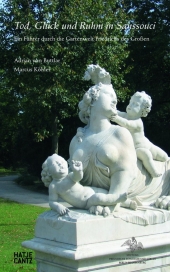 Neuerscheinungen 2012Stand: 2020-01-07 |
Schnellsuche
ISBN/Stichwort/Autor
|
Herderstraße 10
10625 Berlin
Tel.: 030 315 714 16
Fax 030 315 714 14
info@buchspektrum.de |

Adrian von Buttlar, Marcus Köhler
(Beteiligte)
Tod, Glück und Ruhm in Sanssouci
Ein Führer durch die Gartenwelt Friedrichs des Großen. Hrsg.: Stiftung Preußische Schlösser und Gärten Berlin-Brandenburg. Vorw. v. Helmut Dogerloh
Text: Buttlar, Adrian von; Köhler, Marcus
2012. 160 S. 110 farbige Abb. 20 cm
Verlag/Jahr: HATJE CANTZ VERLAG 2012
ISBN: 3-7757-3314-0 (3775733140)
Neue ISBN: 978-3-7757-3314-4 (9783775733144)
Preis und Lieferzeit: Bitte klicken
Der Schlüssel zum inhaltlichen Verständnis der weltberühmten Gartenanlage
Friedrich der Große als Gärtner? Das ist neu. Tatsächlich aber wurde der Garten von Sanssouci unter seiner eigenwilligen Regie zum Spiegelbild seiner persönlichen und politischen Rolle. Wegeführungen, Pflanzungen, Bau- und Bildwerke drücken seine Vorstellungen von Tod, Glück und Ruhm aus. Friedrich nutzte bekannte mythologische Repräsentationsformen, aber auch geheimnisvolle allegorische Anspielungen und emblematische Hinweise. Die ´Achse der Erkenntnis´ definiert sein preußisches Arkadien als beste aller Welten, wo sich der ´Philosoph von Sanssouci´ mit seinen Freunden den Künsten und Wissenschaften widmete. Die ´Achse der Macht´ repräsentiert hingegen seinen Ruhm und Anspruch als europäischer Monarch, der sich nicht nur über die Dynastien der Hohenzollern und Oranier, sondern auch aus der Tradition der Pharaonen, der römischen Kaiser und des Sonnenkönigtums Ludwigs XIV. legitimierte.
Frederick the Great as a gardener? That is something new. In fact, however, under Fredericks idiosyncratic guidance, the garden at Sanssouci became a mirror of his personal and political roles. Paths, plantings, architecture, and sculptures express his notions of death, happiness, and fame. Frederick used famous forms of mythological representation, as well as mysterious allegorical allusions and emblematic references. The axis of knowledge defined his Prussian Arcadia as the best of all possible worlds, where the philosopher of Sanssouci and his friends devoted themselves to the arts and sciences. The axis of power, on the other hand, represents his fame and ambition as a European monarch who legitimized his rule not only via the Hohenzoller and Orange dynasties, but also through the tradition of the pharaohs, the Roman emperors, and Louis XIV, the Sun King.
Frederick the Great as a gardener? That is something new. In fact, however, under Frederick s idiosyncratic guidance, the garden at Sanssouci became a mirror of his personal and political roles. Paths, plantings, architecture, and sculptures express his notions of death, happiness, and fame. Frederick used famous forms of mythological representation, as well as mysterious allegorical allusions and emblematic references. The axis of knowledge defined his Prussian Arcadia as the best of all possible worlds, where the philosopher of Sanssouci and his friends devoted themselves to the arts and sciences. The axis of power, on the other hand, represents his fame and ambition as a European monarch who legitimized his rule not only via the Hohenzoller and Orange dynasties, but also through the tradition of the pharaohs, the Roman emperors, and Louis XIV, the Sun King.


